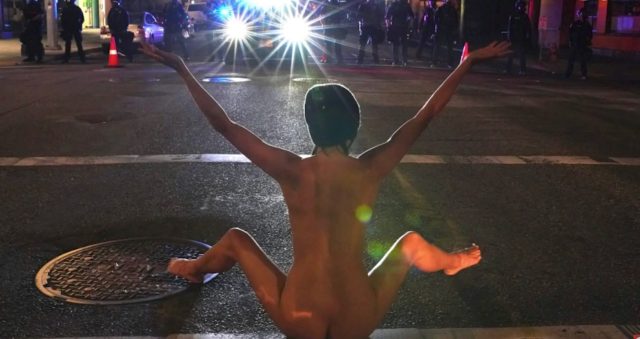
Here she is, gleaming in the dark, all skin as she advances on the armed police sent to flatten the Black Lives Matter movement in Portland: a female protestor wearing nothing but beanie and facemask.
“And then? Naked Athena appeared and the little boys didn’t know what to do,” tweeted photographer Donovan Farley, who captured the moment, as though her nakedness alone was enough to shame the armed officers. Actually, they fired pepper balls at her feet, but she remained on the street doing yoga, and according to another witness, the officers dispersed about 10 minutes later.
https://twitter.com/DonovanFarley/status/1284410621283328000?s=20
The internet being the internet and social justice being social justice, all this eventually devolved into a conversation about whether the light-skinned protestor was in fact a problematic exerciser of her white-privilege, whether doing yoga is actually colonialism, and whether she even was a she at all, or of some other more compelling identity. No matter: the image stands for itself, a little absurd in the incongruity of flesh and firearms, a lot striking in the steadfastness of her stance. Something unforgettable about it. Something about it that you already know, as well.
Female nudity as protest is as old as anything. At first I thought of Sixties counter-culture shock tactics such as Yoko Ono’s Cut Piece — Ono in a white gown, inviting the audience to cut away her clothing until she was completely naked, which would by some mysterious process bring about world peace. But it goes back further than that. Apocryphal Godiva, naked on her horse sometime in the eleventh century, in opposition to her husband’s taxes. Liberty leading the people, bare breasted atop the fallen of the French Revolution. These are men’s versions of women’s bodies as emblems of freedom, stamped on our common imagination.
A naked man does not mean the same thing as a naked woman. For one thing, there is a lot more of a man you can put on show without breaking any taboo — although there are much graver taboos around that bit you aren’t supposed to show. But there’s more to it than that. As John Berger said: “A man’s presence suggests what he is capable of doing to you or for you,” but “a woman’s presence expresses her own attitude to herself, and defines what can and cannot be done to her”.
A man naked is a flasher, a threat (there’s a reason men send unsolicited dick pics, and they’re not a courting ritual, they’re an act of aggression); either that, or he’s simply ridiculous, emasculated by his exposure. His body doesn’t work as protest. A woman naked, though, is a study in defiant vulnerability. What can be done to her? Anything – she’s a naked woman. What can be done to her? Nothing that she hasn’t pre-empted with her self-display. In a limited sort of a way, she is in control.
Or to put it another way, female nudity as protest makes sense in a way male nudity doesn’t, because looking at women makes sense to us in a way that looking at men doesn’t. Despite some great steps forward in letching over men (for which, my most sincere thanks to the homosexual agenda), you only have to spend five minutes on Instagram to figure out that one sex still exists to be eyeballed while the other gets to do the eyeballing.
Feminist naked protest has tried gamely to overturn objectification, with women voluntarily stripping off to prove their bodies are their own. The Slutwalk protests began in 2011 as a reaction to a Toronto police officer who offered the rape prevention advice that “women should avoid dressing like sluts”. But the difference between having your tits out, and having your tits out ironically, is a very thin one. Activism that can safely be called “hot” probably isn’t that much of a challenge to men’s sexual entitlement.
Ukrainian feminist group Femen made headlines with multiple topless stunts that went nipple-first against targets including Vladimir Putin and France’s Front National party. Then a 2013 documentary revealed that Femen was – surprise! — the creation of a man, Victor Svyatski. “These girls are weak,” he says in the film. “They don’t have the strength of character. They don’t even have the desire to be strong. Instead, they show submissiveness, spinelessness, lack of punctuality, and many other factors which prevent them from becoming political activists. These are qualities which it was essential to teach them.” And how better to teach them than by getting them out of their bras? This ought to be all the depressing proof anyone needs that the political display of female flesh is directed by the male gaze.
Getting naked is intensely personal, but the moment a woman protestor drops her clothes is the moment she becomes a symbol, an object – an Athena, a Godiva – in a way that would be an indignity if you were gazing at a man. Men should remain their own selves: only women are supposed to have so little individuality that these archetypes can be impressed on them.
One more iteration of the language of female skin. There’s a power in that Portland picture, even if you know it’s a bit silly, even if you know deep down that armed police probably can’t be scared off by a vagina. It’s not a power that comes from radicalism, though, or even from transgression. And it’s not a power that can be said to belong to the woman. The one detail I can’t stop thinking about is the Twitter bio of the photographer who recorded and named Athena: the first credit he boasts of is Playboy. The male gaze business is always just the male gaze business.










Join the discussion
Join like minded readers that support our journalism by becoming a paid subscriber
To join the discussion in the comments, become a paid subscriber.
Join like minded readers that support our journalism, read unlimited articles and enjoy other subscriber-only benefits.
Subscribe